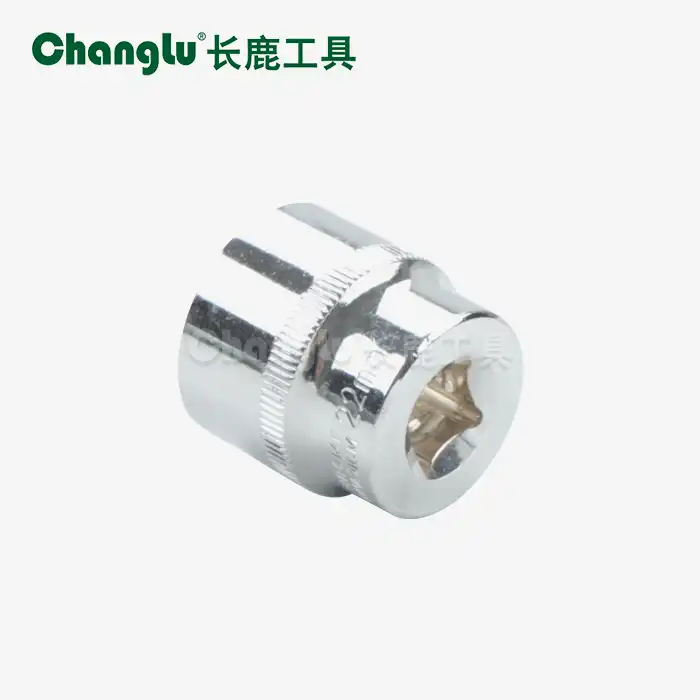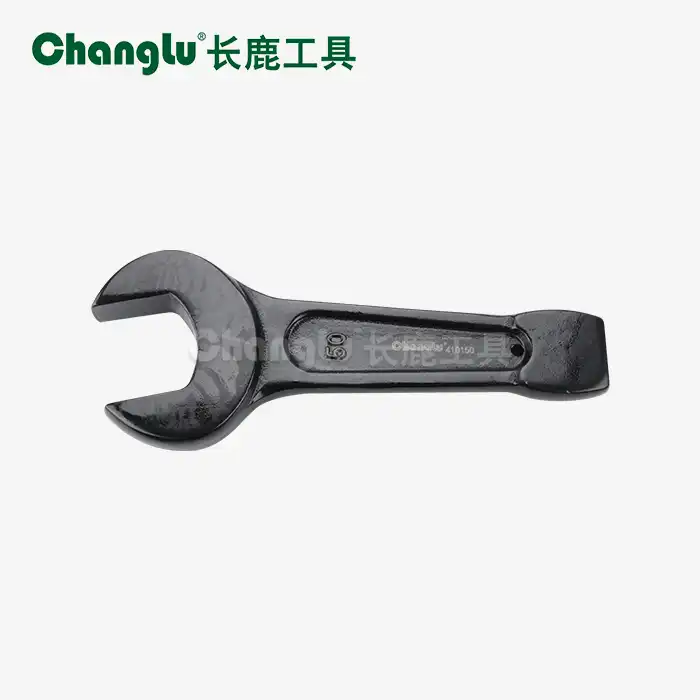Key Differences in Design and Functionality
Design Features
The single-ended open-end wrench is characterized by its flat, open-jawed design on one end of a straight handle. This configuration allows for easy lateral entry onto nuts and bolts, making it particularly useful in confined spaces where a full rotation isn't possible. The open end is typically angled at 15 degrees to the handle, providing additional clearance and allowing for a better grip on fasteners.
In contrast, socket wrenches consist of a ratcheting handle and interchangeable sockets. The ratchet mechanism allows for continuous rotation without removing the tool from the fastener, while the deep well of the socket provides a secure grip around the entire nut or bolt head.

Functionality and Applications
The one-end spanner excels in situations requiring quick adjustments or when working in tight spaces where a socket wrench might not fit. It's particularly useful for tasks such as adjusting brake calipers, working on plumbing fixtures, or accessing fasteners in recessed areas of machinery.
Socket wrenches, however, are preferred for tasks requiring high torque or repetitive tightening and loosening. They're ideal for jobs like changing tires, major engine work, or assembly line operations where efficiency and consistent torque application are crucial.
Pros and Cons for Various Automotive Tasks
Advantages of Single-Ended Open-End Wrenches
- Versatility in tight spaces: The slim profile of a single-head open-end wrench allows it to access nuts and bolts in cramped areas where bulkier tools can't reach.
- Quick engagement: The open-end design permits rapid placement and removal from fasteners, ideal for tasks requiring frequent adjustments.
- Simplicity: With no moving parts, these wrenches are durable and less prone to mechanical failure.
- Lightweight: Their simple design makes them easy to carry and maneuver, reducing user fatigue during extended use.
Disadvantages of Single-Ended Open-End Wrenches
- Limited torque: The open-end design can slip off fasteners when applying high torque, potentially leading to rounded edges on nuts and bolts.
- Size-specific: Each wrench is limited to a specific size, requiring a full set for comprehensive coverage.
- Manual reset: Users must manually reposition the Single-ended open-end wrench after each turn, which can be time-consuming for tasks requiring many rotations.
Advantages of Socket Wrenches
- High torque capacity: The enclosed design provides a secure grip, allowing for the application of significant force without slippage.
- Efficiency: The ratcheting mechanism enables continuous rotation without removing the tool from the fastener.
- Versatility: Interchangeable sockets allow a single tool to handle a wide range of fastener sizes.
- Precision: Many socket sets include torque wrenches for accurate tightening to specified torque values.
Disadvantages of Socket Wrenches
- Bulkier profile: The socket and ratchet combination can be too large for some confined spaces.
- Complexity: More moving parts mean a higher potential for mechanical issues over time.
- Initial cost: A comprehensive socket set with various sizes and accessories can be more expensive than a set of open-end wrenches.
Choosing the Right Tool: Expert Mechanic Tips
Assessing the Task
When deciding between a single-ended open-end wrench and a socket wrench, consider the following factors:
- Space constraints: If you're working in a tight area with limited access, a slim open-end wrench might be your best bet.
- Torque requirements: For high-torque applications or precise torque settings, opt for a socket wrench with a torque adapter.
- Fastener condition: If dealing with worn or damaged fasteners, a socket wrench's enclosed grip may provide better purchase and reduce the risk of further damage.
- Frequency of use: For repetitive tasks, the efficiency of a ratcheting socket wrench can save significant time and effort.
Material Considerations
The quality of the tool material is crucial for both single head open-end wrenches and socket wrenches. Premium tools crafted from chrome vanadium steel offer superior strength and corrosion resistance, essential for long-term durability in professional settings. For instance, our wrenches feature precision-machined open ends for a secure grip on fasteners, complemented by an ergonomic design that reduces hand fatigue during extended use.

Specialized Applications
Certain industries may favor one tool over the other. For example:
- Automotive assembly lines often prefer socket wrenches for their speed and consistency in repetitive tasks.
- Maintenance technicians in industrial settings might lean towards one-end spanners for their versatility in accessing various machine components.
- HVAC technicians may find open-end wrenches indispensable for adjusting fittings in confined spaces.
Combining Tools for Optimal Efficiency
Many professional mechanics recommend having both types of tools in your arsenal. A comprehensive toolkit might include:
- A set of single-ended open-end wrenches in common sizes (24mm to 75mm)
- A socket set with ratchet handle and various socket sizes
- Specialty wrenches for specific applications (e.g., flare nut wrenches for brake lines)
This combination ensures you're prepared for a wide range of tasks, from quick adjustments to major overhauls.
Maintenance and Care
Regardless of your choice, proper tool maintenance is crucial for longevity and performance:
- Clean tools after each use to prevent rust and corrosion
- Store in a dry environment, ideally in a toolbox or on a pegboard
- Regularly inspect for wear or damage, especially on the working surfaces
- Apply a light coat of machine oil to metal surfaces to prevent rust
By following these tips, you can ensure that your wrenches, whether open-end or socket, remain in top condition for years of reliable service.
Conclusion
In the debate between single-ended open-end wrenches and socket wrenches, there's no clear winner. Each tool has its strengths and ideal applications. The single-ended open-end wrench shines in situations requiring quick access and adjustments in tight spaces, while the socket wrench excels in high-torque applications and repetitive tasks.
For experts in the equipment and hand instrument industry, having an assorted toolkit that incorporates both sorts of torques is regularly the best approach. This guarantees you're prepared for any challenge, whether you're working on car repairs, fabricating gathering lines, or doing mechanical apparatus maintenance.
Are you looking for high-quality, solid torques for your trade? Shandong Changlu Devices Co., Ltd. specializes in making premium hand instruments planned to meet the needs of different businesses. Our broad run incorporates both single-ended open-end torques and attachment sets, all fabricated to demanding guidelines utilizing high-grade materials.
As an executive of the China Equipment and Chemical Industry Affiliation and an official part of a few industry chambers, we understand the significance of quality, competitive pricing, and timely delivery. Our commitment to greatness has made us a trusted provider for businesses of all sizes, from little workshops to huge mechanical operations.
Don't let unstable quality, unsuitable prices, or unpredictable delivery times hinder your operations. Explore our range of professional-grade tools and experience the Shandong Changlu difference. For more information or to discuss your specific needs, please contact us at changlu@shukuntools.com. Let us help you equip your team with the right tools for success.
References
1. Johnson, A. (2022). The Mechanic's Handbook: Choosing the Right Wrench for Every Job. Automotive Press.
2. Smith, B. (2021). Industrial Maintenance: Tools and Techniques. Engineering Solutions Publishing.
3. Davis, C. (2023). Ergonomics in Hand Tool Design: Improving Efficiency and Reducing Fatigue. Occupational Health Journal, 45(3), 78-92.
4. Thompson, D. (2020). The Evolution of Wrenches: From Ancient Times to Modern Day. Tool History Quarterly, 18(2), 112-126.
5. Liu, R., & Patel, S. (2022). Comparative Analysis of Wrench Types in Automotive Assembly Lines. Journal of Manufacturing Engineering, 33(4), 201-215.
6. Wilson, E. (2023). Material Science in Hand Tool Manufacturing: Advancements and Challenges. International Journal of Metallurgy, 56(1), 45-59.

_1751941258847.webp)

_1751594101285.webp)